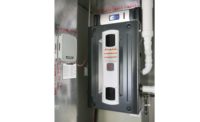While most homeowners will understand the importance of their furnace of air conditioner operating efficiently, many may underestimate the importance of quality ventilation. Ductwork might be hidden out of sight, so subprime ventilation could be unnoticeably causing discomfort and higher energy bills.
The Importance of Ventilation
“Proper ventilation is extremely important to health of the home and the occupants,” said Mark Terzigni, executive director of market sectors and construction technology at SMACNA. “For occupants, proper ventilation dilutes contaminants, such as allergens, carbon dioxide, and biological contaminants. The key is to provide proper ventilation and not just ventilation. Proper ventilation involves filtering the air.”
It’s estimated that people spend about 90% of their time indoors, and that indoor air can be polluted from anywhere between five to 100 times more than the outdoor air, posing a significant risk to people. This could include particulate and volatile organic compounds from building materials and cleaning chemicals getting sealed inside.
Not only that, but under-ventilation leads to stuffy and stale air. Over-ventilated air can cause excess humidity in the summer, and excessive dryness in the winter.

PROPER VENTILATION: “The key is to provide proper ventilation and not just ventilation. Proper ventilation involves filtering the air,” said Mark Terzigni, executive director of market sectors and construction technology at SMACNA. (Courtesy of SMACNA)
First Steps
David Richardson, curriculum developer and trainer at the National Comfort Institute (NCI), said that one of the first steps in diagnosing a ventilation issue is examining where the air is coming from.
“When we leave ventilation to chance, the air often comes from places that no one should or wants to breathe,” he advised. “Ventilation should come though the HVAC system, not a leaky building and places connected to it like an attic or crawlspace.” Measuring airflow and/or building leakage can help track where the air is coming from and going.
Symptoms from poor ventilation can include odors in the home from pets, trash, or cleaning solvents, as well as health issues (itchy or watery eyes, skin irritations, nose and throat irritation, nausea, and headaches, for example).
“In order to diagnose a ventilation issue, technicians should first confirm if the HVAC system is properly sized, if the system startup procedure was documented, and if there have been any modifications to the space, such as an addition, new windows, a finished basement, or closed registers,” said Tom Tasker, product manager, residential ducted systems, Johnson Controls. “Next, it’s important to confirm that the mechanical room is free of chemicals, mold, and dust, and that routine maintenance is taking place for air filters and evaporator coils.”
Diagnosing ventilation issues should also include listening well to homeowners, according to Terzigni. They may list symptoms that point to a ventilation issue. Technicians can then inspect the indoor comfort system, being aware that the home is a complete system. For example, increasing the outdoor air brought will only work sufficiently if the existing equipment can handle the additional heating and cooling loads.
Excess moisture, such as a moldy/damp crawlspace or basement, can indicate a ventilation issue. David Burd, technical manager, Owens Corning North American Technical Insulation, advised that this can be seen in discoloring of framing or staining on walls.
“Verify that the current HVAC air handling unit and duct system is properly sized. Determine the rated output of the AHU and measure the output at each supply register,” said Burd. “The sum of the outputs at all the registers should equal or be very close to the rated output of the AHU.”
Attics also present a potential spot for ventilation issues. Technicians should verify that the attic has proper ventilation that meets FHA/Code minimums for Net Free Vent Area. They should also make sure that soffit ventilation is not plugged or covered by insulation. Damp spots on rafters or roof sheathing can be indicative of a ventilation problem.
Technicians can also measure the pressure of a system before and after the filter to see if the system is running efficiently. A leaky system can lead to poor IAQ and force the air handling unit to work harder than it should to ventilate the building.
Inspecting and Repairing Ventilation Systems
What should technicians be looking for during an inspection?
“I would recommend starting with what they are familiar with — the HVAC equipment,” said Richardson. “Look for visual clues such as duct leakage and filter bypass near the equipment, especially if the equipment is in an unconditioned space like an attic or crawlspace.”
After that, Richardson recommended that technicians look at the duct system, as a leaky duct system can cause a lot of unintended ventilation.
Paul Heimann, vice president at Welsch Heating & Cooling Co., said that a complete and thorough inspection is key. Annual inspections can help ensure the system is working properly and can identify and remediate early issues before they grow in size. And while ventilation is critical, it is just one component of a larger system. Proper filtration and humidity control play an important role in keeping inhabitants comfortable.
Pressuring testing the whole system will help determine its overall health, and if needed, leaky old ducts should be replaced with new ducts that have minimal leakage. Filters should be changed according to the manufacturer’s recommended schedule, and the system needs to be properly sized and balanced.
“Small areas of concern may be air leakage from the conditioned space from things like light fixtures, chases or even open walls or unsealed holes for electrical or plumbing,” said Burd. “Larger areas could be from a kitchen hood vent or bathroom vent that is just placed into the attic and not outside.”
David Richardson reminded technicians that instead of guessing at ventilation needs of a building, they should use industry-approved standards to decide how much ventilation needs to be improved. Then they can begin working on a strategy to fix it.
If ducts are not sized correctly, air won’t go where it needs to, leading to issues with temperature control and humidity levels. Dirty ductwork could indicate poor filtration and impact the airflow and IAQ of the home.
“If the coils are dirty, that would also impact the efficiency of the system,” said Terzigni. “Excessive leakage can lead to unfiltered air entering the system as well as less-than-desirable airflow reaching the appropriate spaces. This is why it is important to evaluate the system as a whole and not focus on a single issue.”
Safety and Ventilation
Ventilation can have a direct impact on homeowner safety. Steve Simmons, co-owner of Air Comfort Heating & Cooling, explained that properly sealed air ducts are much more critical than most believe. This can be a key difference maker in protecting people from radon.
“While naturally radon is more concentrated in lower levels of homes, a poorly sealed return duct system can literally bring it right up to the top levels of a home,” he said. “We’ve measured high radon levels on multi-story homes and typically find a very leaky duct system is a major contributor.”
He also added that duct cleaning, prober filtration, and sufficient air flow all contribute to a healthy indoor comfort system. Even brand new duct systems can be poorly installed, or a perfectly-installed system may grow contaminated with time.
“Both situations need to be remedied,” he said.








